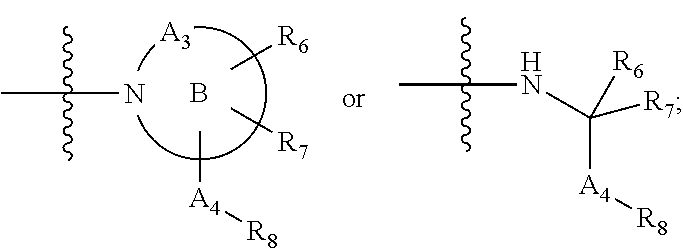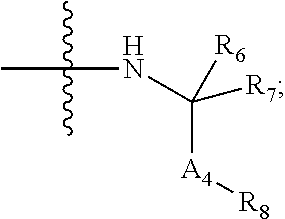Iap binding compounds
a technology of iap and binding compounds, which is applied in the field of iap binding compounds, can solve the problems of human cancer development and progression, short half-life due to proteolytic degradation in the body, and tumor cells capable of evading programmed cell death often become resistant to treatment, and achieve the effect of promoting apoptosis
- Summary
- Abstract
- Description
- Claims
- Application Information
AI Technical Summary
Benefits of technology
Problems solved by technology
Method used
Image
Examples
examples
[1289]In the following examples and preparations, unless stated otherwise, all operations were carried out at room or ambient temperature, that is, in the range of 18-25° C., evaporation of solvent was carried out using a rotary evaporator under reduced pressure with a bath temperature of up to 60° C., reactions were monitored by thin layer chromatography (TLC) and reaction times are given for illustration only; All melting points (mp) were determined in open capillary tubes using a Büchi B-540 Melting Point instrument and are uncorrected (polymorphism may result in different melting points); the structure and purity of all isolated compounds were assured by at least one of the following techniques: TLC (Merck silica gel 60 F254 precoated TLC plates), mass spectrometry or nuclear magnetic resonance spectra (NMR). Yields are given for illustrative purposes only. Workup with a cation-exchange column was carried out using MP-TsOH cartridge (Argonaut), which was preconditioned with dich...
preparation 1
6-(1-(2-nitrophenylsulfonamido)ethyl)piperidine-2-carboxylic acid
[1295]
Step 1. 6-(1-Amino-ethyl)-piperidine-2-carboxylic acid ethyl ester
[1296]Synthesised according to Method Q, Step i and ii:
[1297]To 6-acetyl-pyridine-2-carboxylic acid methyl ester (0.11 g, 0.63 mmol) dissolved in ethanol-water (1.5 mL, 2:1) was added hydroxylamine hydrochloride (0.043 g, 0.63 mmol) and sodium acetate (0.051 g, 0.63 mmol). The reaction mixture was stirred overnight at 55° C. The reaction was concentrated under reduced pressure and redissolved in DCM (10 mL). The organic phase was washed with water, dried over sodium sulfate, filtered and evaporated under reduced pressure. The residue was dissolved in ethanol (4 mL) followed by the addition of concentrated sulphuric acid (0.1 mL) and 5% rhodium on carbon (0.01 g). The mixture was hydrogenated at 15 bars for two days at room temperature. The reaction mixture was filtered through celite and the solvent evaporated under reduced pressure to afford 94 mg...
preparation 2
3-(1-(2-nitrophenylsulfonamideo)ethyl)benzoic acid
[1300]
Step 1. 3-(1-Amino-ethyl)-benzoic acid
[1301]Synthesised according to Method P, Step i:
[1302]A solution of 3-acetylbenzoic acid (0.164 g, 1.0 mmol) and ammonium formate (0.315 g, 5.0 mmol) in methanol (1 mL) was cooled to −78° C. in a schlenk tube and degassed by three freeze thaw cycles. The schlenk tube was heated to room temperature and dichloro(pentamethylcyclopentadienyl)rhodium(III) dimer (0.031 g, 5.0 μmol) was added. The schlenk tube was closed and the reaction stirred for 3 hours at 50° C. The mixture was cooled to room temperature. The product was filtered off; washed with methanol and dried in vacuo to afford 0.11 g of the title compound.
Step 2. 3-(1-(2-nitrophenylsulfonamideo)ethyl)benzoic acid
[1303]Synthesised according to Method T, Step i:
[1304]3-(1-Amino-ethyl)-benzoic acid (0.10 g, 0.61 mmol) was dissolved in dioxan-water (1:1, 6 ml). Sodium carbonate (0.19 g, 1.83 mmol) and 2-nitro-benzenesulfonyl chloride (0.16...
PUM
| Property | Measurement | Unit |
|---|---|---|
| affinity | aaaaa | aaaaa |
| resistance | aaaaa | aaaaa |
| stability | aaaaa | aaaaa |
Abstract
Description
Claims
Application Information
 Login to View More
Login to View More - R&D
- Intellectual Property
- Life Sciences
- Materials
- Tech Scout
- Unparalleled Data Quality
- Higher Quality Content
- 60% Fewer Hallucinations
Browse by: Latest US Patents, China's latest patents, Technical Efficacy Thesaurus, Application Domain, Technology Topic, Popular Technical Reports.
© 2025 PatSnap. All rights reserved.Legal|Privacy policy|Modern Slavery Act Transparency Statement|Sitemap|About US| Contact US: help@patsnap.com



